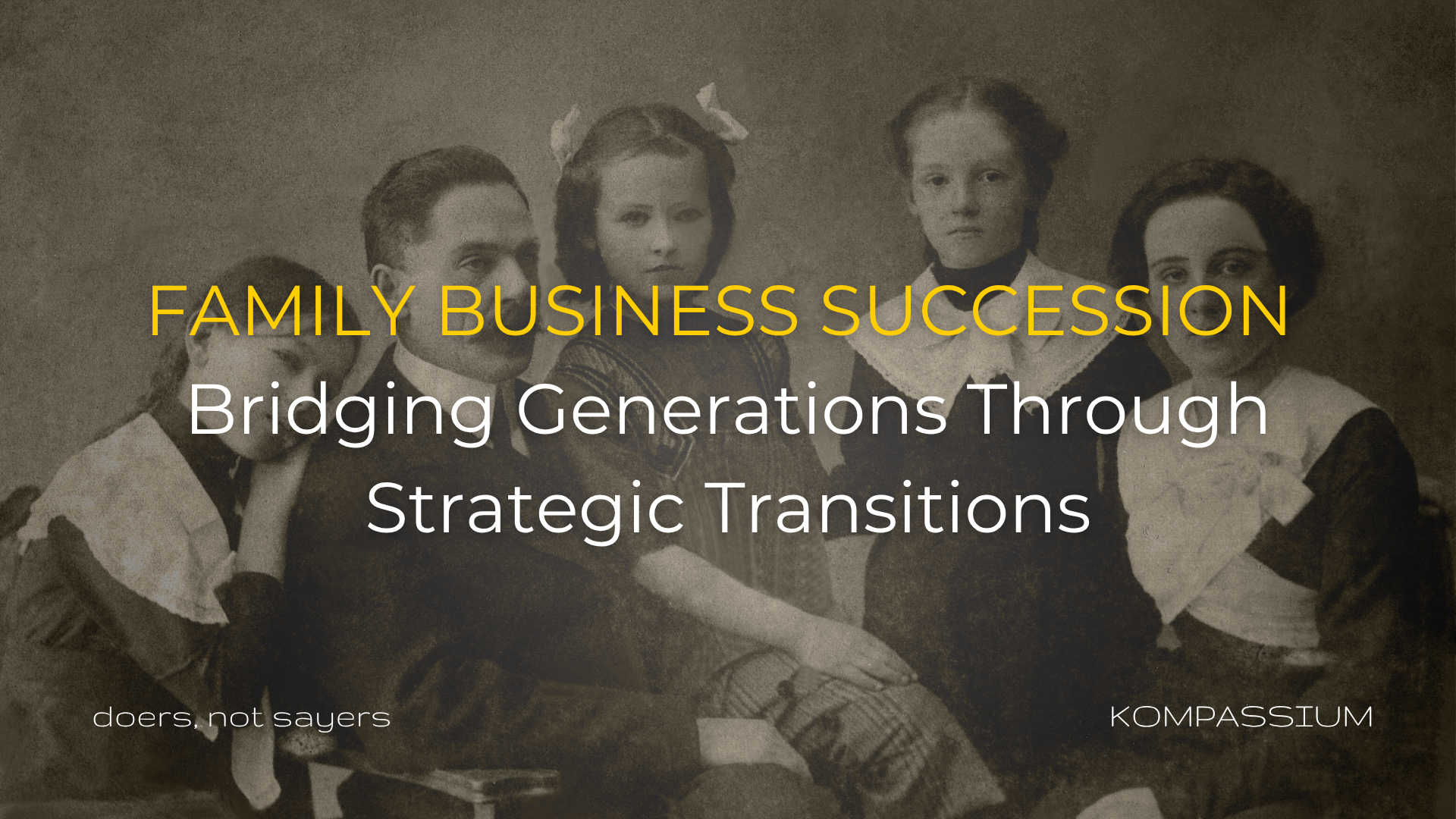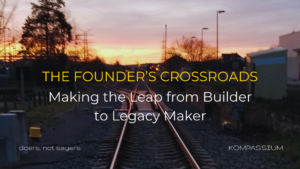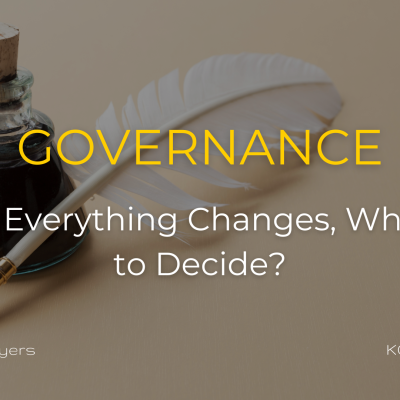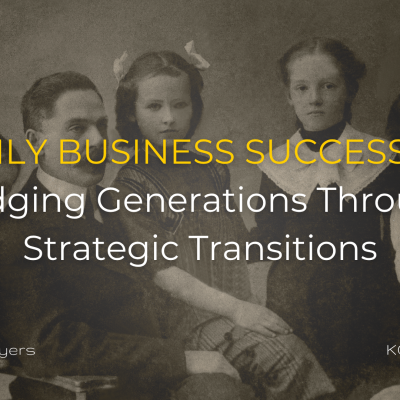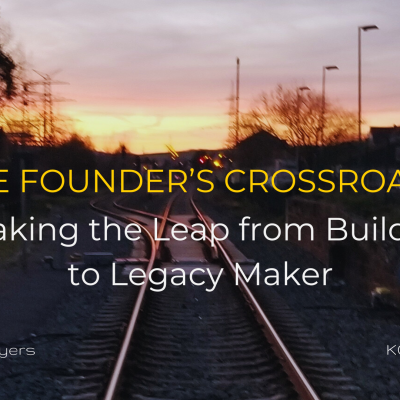Bridging Generations Through Strategic Transitions
Fabiana Domingues, Mauro Trevisani, and Marcos Leal are part of KOMPASSIUM’s global leadership team.
At some point in every family business journey, founders face a profound question that transcends balance sheets and market share:
“What will happen to everything I’ve built when I’m no longer here to lead it?”
This question marks the beginning of perhaps the most challenging leadership test business owners will face—the transition of power and purpose between generations. This transition is undoubtedly one of the most complex decision-making processes for those considering the impact on their family across generations.
Family business succession is where business vision meets family legacy, where corporate strategy intersects with deeply personal values. It’s a territory where practicality and emotions are inseparable, and today’s decisions echo for future generations.
In a previous article, “The Founder’s Crossroads,” we examined founders’ dilemmas when deciding whether to continue building or pass the baton through external transitions such as mergers or acquisitions. Now, we focus on a different path at that same crossroads—keeping the business within the family and successfully transitioning leadership between generations.
The integration between professional and personal life is particularly pronounced in family businesses, which can make the necessary transition more complex. Beyond succession management as a whole, considering family wealth succession—accounting for each individual and the inheritance laws that affect estate distribution, probate processes, and proper will creation—provides even greater security and peace of mind throughout the process.
In parallel, as the company transitions, the founder’s assets, including property and rights, will be strategically outlined for the future and for heirs, in accordance with their wishes and best practices (and the associated legislation), to strengthen business succession. At this important stage of succession planning, desires, needs, concerns, and the quest for security—ensuring heirs’ support and business continuity —are identified and addressed.
Beyond Business: The Multi-Generational Enterprise
Family businesses are the backbone of the global economy, representing approximately 70-90% of global GDP and creating 50-80% of jobs in most countries. However, research consistently shows that only 30% survive to the second generation, 12% reach the third, and only 3% continue beyond that1 . These statistics reveal the founders’ dilemma: family business succession is challenging and must be carefully planned and executed.
Why do so many family businesses fail during succession? The answer lies in understanding that a family business isn’t merely run by family members—it’s a complex, adaptive system where business dynamics, family relationships, ownership and governance structures, and individual aspirations constantly interact and evolve.
The Three-Dimensional Model: Understanding and Addressing Family Business Complexities
To comprehend all the challenges and opportunities of the family business succession process, we need to recognize the overlap of three systems2:
- Business system: The operational entity that must remain competitive and adaptable in the marketplace
- Family system: The network of relationships, values, and dynamics that define the controlling family
- Ownership system: The structure through which control and economic value are distributed
Each system operates according to its own logic, timeline, and objectives. Successful succession planning requires harmonizing these three systems rather than focusing exclusively on one dimension.
For example, naming the oldest son or daughter as CEO may satisfy traditional family expectations but could be disastrous if they lack the skills to lead the company in a competitive market. Similarly, selecting a more qualified non-family executive may optimize company performance but could generate family conflicts if not managed with sensitivity to family dynamics and ownership concerns.
The Emotional Dimension: Navigating Identity and Purpose
Succession planning isn’t just a strategic exercise for founders—it’s a profound psychological journey that requires confronting mortality, legacy, and identity.
A family member of a second-generation manufacturing company shared a critical reflection with one of our partners:
“As one of three brothers who own a car dealership network in the interior of São Paulo, my fear is what will happen when I’m gone, as my wife, daughter, and granddaughter don’t have the skills for the business. I need the business to maintain their standard of living, and more importantly, I don’t want my son-in-law to have any control over the assets I’m leaving behind.” – she said.3
This sentiment echoes what many founders experience—their identities as family members and managers have become so intertwined with their businesses that succession planning feels like planning for the loss of self. This emotional dimension often leads founders to indefinitely postpone succession planning, creating vulnerability for the company and the family.
In succession planning, focusing on inheritance transmission, various hypotheses are raised to achieve the outlined objectives, including time optimization and tax efficiency. Agreements preceding marriages and stable unions, formalizations of unions with strategic definitions of property regimes, and simulations considering premature deaths or disruptions such as divorces that directly influence life and business are analyzed and can be directed. Not only is death considered, but incapacities due to health problems and accidents are taken into account in planning and succession involving companies and families.
The successor generation faces psychological challenges. They must establish their own leadership identity while honoring and helping evolve the legacy they’re inheriting, anticipating the future of their markets, clients, and consumers. New generations must gain credibility while working in the shadow of founding members and navigate complex family dynamics as they make difficult business decisions.
According to the testimonial given to another KOMPASSIUM partner by the owner of a specialty chemical distributor in the USA:
“I thought one of my children, after completing an MBA at one of the top universities in the US, would succeed me. However, after analyzing, understanding, and accepting that we had personal limitations in knowledge regarding execution and understanding of certain tools like contracts and this S&OP thing, we decided to hire an executive with the power to make changes and transformation”— he said.
The Four Pillars of Successful Family Business Succession
Through our partners’ practical experience, whether advising families, companies across various sectors, or private equity funds, we’ve identified four essential pillars that support successful succession:
1. Strategic Clarity: Purpose Alignment Across Generations
Successful succession begins with clarity about what the company stands for and where it’s headed—this requires an open dialogue about:
- The core purpose and values of the business
- The shared vision for its future
- The strategic direction needed to achieve that vision
- The role family members should play in the future
This dialogue should unite generational perspectives, honoring the wisdom of experience while embracing the innovation of younger generations. When these conversations don’t happen, succession often becomes paralyzed, as uncertainty about direction creates hesitation about leadership transition.
A global food ingredients company faced this type of challenge. The founder built the business around products increasingly adopted by different sub-segments worldwide. However, decisions made by next-generation members didn’t align with the new dynamics of the global market, which were different from those experienced in earlier phases of the company. What was successful in the past won’t necessarily keep pace with market evolution, especially as new consumer trends emerge. It’s important to know when you need external help and when to collaborate.
2. Governance Excellence: Creating Systems That Transcend Individuals
As family businesses grow across generations, they require governance structures that can manage increasing complexity—this means developing:
- Clear decision-making processes that distinguish between family, ownership, and business decisions
- Formalized roles, responsibilities, and accountability mechanisms
- Professional boards with independent directors who bring an outside perspective
- The presence of an independent chairman of the board is also a fundamental element
- Family councils that provide a forum for addressing family concerns separately from business operations
- Family constitutions or protocols that codify shared values, policies, and expectations
These structures don’t replace the need for strong leadership; they create the framework within which leadership can flourish across generations. They also provide crucial continuity during leadership transitions.
In a time when becoming a “board member” seems like the opportunity of the moment for many executives, it’s fundamental to understand that corporate governance goes far beyond preparation for an IPO or meeting regulatory requirements. It’s critical to establish solid governance consistent with family structures that may (or may not) influence the company’s transition journey. This governance must envision the company’s future across generations and ensure transparency for external stakeholders.
3. Capability Development: Preparing the Next Generation
Historically, there have been various approaches to educating the next generations about the business and helping them navigate the complex decisions they’ll face multiple times during their lives:
- What should my children learn about the business?
- What about subjects to be added to their formal education, or should we have a dedicated long-term program for all next-generation members?
- Should I force them into specific careers?
- Can we have a prenuptial agreement?
- Should they be trained elsewhere before joining the company?
Successful succession requires intentional development of the capabilities needed for future leadership—this includes:
- Early, age-appropriate exposure to the business
- Formal education aligned with business needs
- External work experience that builds credibility and perspective
- Mentoring relationships with non-family executives
- Progressively challenging roles within the family business
- Opportunities to lead significant initiatives or divisions
- Honest feedback and performance assessment
The most successful family businesses start this development process early, creating pathways for next-generation members to earn their positions through demonstrated capability rather than birthright.
We’ve seen a mix of questions and solutions, some of which may apply to everyone and others that may take cultural nuances into account.
Daniel Gross’s book, A Banker’s Journey: How Edmond J. Safra Built a Global Financial Empire, describes how Edmond helped enroll his brother, Josef, in a comprehensive training course at Bank of America. Edmond began working as a banker with his father in his early teens. Josef eventually came to be considered the wealthiest banker in the world, while Edmond was known as the best banker of his generation, or “the banker’s banker”4.
4. Communication Mastery: Building Trust Through Dialogue
The quality of communication in business families is directly related to successful succession—this requires:
- Creating safe spaces for honest dialogue
- Developing skills in constructive conflict resolution
- Establishing regular forums for family business communication
- Creating transparency regarding decisions and processes
- Addressing emotional undercurrents rather than focusing solely on business logic
- Celebrating shared history while creating new traditions
When communication breaks down, even the best succession plans fail. Conversely, families with strong communication can navigate even the most challenging transitions. Therefore, it’s essential to have a clear understanding (or buy-in) from all participants in this complex ecosystem, including external entities and individuals, such as strategic partners and leaders who enable operations to continue during critical moments.
Warren Buffett is known for his quotes. In one, he reinforces that:
“…parents should let their adult children read the will before it’s signed.”
The KOMPASSIUM “Legacy” Programs
Navigating family business succession is a journey that benefits immensely from experienced guidance. At KOMPASSIUM, our approach combines deep knowledge with practical implementation, recognizing that succession planning is not an event but a process that unfolds over the years.
Our methodologies are built on these four pillars, helping family businesses develop comprehensive succession systems rather than simple succession plans. We recognize that each family business is unique and requires tailored approaches rather than one-size-fits-all solutions.
Through our Advisory Programs, we bring together selected groups of companies with similar succession challenges, creating powerful learning communities and providing individualized guidance. This approach combines the benefits of personalized consulting with the insights of peer learning.
Our work includes:
- Facilitating strategic dialogue between generations
- Developing governance structures suited to the family’s unique culture
- Creating personalized capability development plans for next-generation leaders
- Building communication forums and skills that support healthy family dynamics
- Helping families address both the logical and emotional dimensions of succession
Transforming Challenge into Legacy: The Phases of Succession Planning
Effective succession planning typically unfolds across four distinct phases:
Phase 1: Foundation Building
This initial phase focuses on establishing the foundations for successful succession, including:
- Articulating and documenting family values and vision
- Creating or strengthening basic governance structures
- Beginning the development of next-generation family members
- Opening a dialogue about succession expectations and timelines
This phase typically begins 10-15 years before an anticipated leadership transition when next-generation members are still developing their capabilities and career directions.
Phase 2: Preparation and Planning
As the succession timeline becomes clearer, the focus shifts to more specific preparation:
- Formalizing succession criteria and processes
- Accelerating the development of potential successors
- Strengthening governance structures to support the transition
- Beginning planning for ownership and property transition
- Creating alignment among key stakeholders
This phase typically occurs 5-10 years before an anticipated transition, providing sufficient time for preparation while maintaining clarity about direction.
Phase 3: Transition Execution
As the actual leadership transition approaches, attention turns to implementation:
- Finalizing successor selection
- Creating specific transition timeline details
- Managing the gradual shift of responsibilities
- Effectively communicating with all stakeholders
- Supporting both incoming and outgoing leaders
This phase typically spans 1-3 years, allowing for a managed transfer that builds confidence and continuity.
Phase 4: Post-Succession Adjustment
After the formal leadership transition, ongoing attention is needed to:
- Support the new leader in establishing authority
- Redefine the role of the previous leader
- Adjust governance to reflect the new reality
- Address any emerging issues or conflicts
- Celebrate the successful transition and maintain momentum
This phase typically lasts 1-2 years, ensuring the transition is complete and sustainable.
By approaching succession planning as a phased process rather than a single event, family businesses dramatically increase their chances of success. They create space for development, dialogue, and adjustment rather than forcing abrupt changes that can destabilize both the company and the family.
Recognized Cases – more globally recognized examples:
Hermès: Protecting Family Control Through Sophisticated Structures5
Hermès International, founded in 1837, has maintained family control across six generations by implementing sophisticated governance structures. In response to LVMH’s hostile takeover attempt in 2010, the family created a limited partnership structure that gave family members veto rights over key decisions and established a family council separate from the board of directors.
Today, approximately 75% of the company is still controlled by around 60 family shareholders, united through a shareholders’ agreement. This governance structure has allowed Hermès to balance professional management with strong family oversight, preserving its artisanal heritage while adapting to modern luxury markets.
Antinori: Twenty-Six Generations of Winemaking Excellence6
The Antinori family has been producing wine in Tuscany since 1385, spanning an extraordinary 26 generations—one of the world’s oldest family businesses. Their longevity stems from a clear succession philosophy articulated by Marchese Piero Antinori, who passed leadership to his three daughters.
The family established a governance structure where members must demonstrate merit and capability before assuming leadership roles. They created a family council and a board that included family and non-family professionals. Particularly notable is how they adapted traditional patrilineal succession to embrace female leadership, with Albiera, Allegra, and Alessia Antinori now leading the company.
Faber-Castell: Eight Generations of Structured Transition7
German writing instrument manufacturer Faber-Castell, founded in 1761, has navigated eight generations of family leadership through a comprehensive governance approach. Their family constitution defines the roles of ownership and management.
Count Anton-Wolfgang von Faber-Castell, who led the company until 2016, implemented professional management structures while maintaining family oversight through a supervisory board. The company established clear criteria for family members’ entry into the business, requiring relevant education and external work experience.
When the eighth-generation leader passed away in 2016, the company successfully transitioned to professional management under family ownership, demonstrating how sound governance can ensure continuity even during unexpected transitions.
These real-world examples illustrate how governance excellence provides the essential framework for family businesses to navigate the complexities of succession across multiple generations. Their approaches differ in specific implementation but share common elements: clear separation of family and business decisions, formal structures for family involvement, and established processes for leadership development and transition.
Bridges or Ruins: What Will You Leave Behind?
As a KOMPASSIUM partner reflected in a recent article:
“Everyone’s career will end someday… like an asteroid, it flashes and goes. So, when and wherever you pass, what do you want to leave behind as a peer, leader, supplier, and customer? Good or bad memories?” – Marcos Leal
For family business leaders, this question takes on multi-generational significance. The succession decisions you make today determine whether you’ll leave behind bridges that connect generations or ruins that mark the end of a legacy.
Successful succession planning builds bridges—structures that connect what came before with what lies ahead, allowing safe passage between generations while standing firm against moments of turbulence. These bridges enable families to cross the chasm that often separates founders’ vision from multi-generational purpose.
The essence of these bridges isn’t found in legal documents or organizational charts, though they have their place. Instead, it exists in relationships, shared values, and governance systems that transfer tangible and intangible assets across generations.
Conclusion: From Succession Planning to Legacy Creation
Family business succession isn’t merely about who the next leaders will be—it’s about creating systems that allow the family business to fulfill its potential as a vehicle for economic prosperity and family purpose across generations.
The most successful family businesses approach succession not as a problem to be solved but as an opportunity to create something enduring. They see beyond the technical challenges of management transition to the deeper opportunity of legacy creation.
These businesses transform succession risk into multigenerational opportunities through strategic clarity, governance excellence, capability development, and communication mastery. They build bridges that connect and strengthen generations, creating more resilient and purposeful businesses with each transition.
The journey isn’t easy, but few worthwhile achievements are. By approaching succession with intention, openness, and willingness to embrace both the logical and emotional dimensions of the process, family businesses can defy the odds and create legacies that truly stand the test of time.
For founders at a crossroads, pondering the future of all they’ve built, the path of family succession offers a unique opportunity to see their vision and values extend far beyond their leadership. With proper planning and support, that vision doesn’t diminish with succession—it multiplies as each generation builds upon the foundation and adds its unique contribution to the family legacy.
In the end, what can be stated is that the absence of planned succession can be catastrophic because it is certain that succession arrives in business and family life, and not having acted can mean a probate process that blocks business management, garnishes income, congests the sale or corporate merger, allocation of shares or portions beyond descendants, diluting assets in the family line, among other practical aspects, and then, finally, the ruin of an empire built with much sweat, strength, and struggle. The legacy, in this case, will be only memories.
Fabiana Domingues, Mauro Trevisani, and Marcos Leal are members of KOMPASSIUM, a global network of experienced leaders committed to business transformation and sustainable growth. With over 700 years of combined leadership experience across its network, KOMPASSIUM specializes in uniting expertise with practical strategic execution, generating transformative and lasting impact for its partners and the ecosystems in which they operate.
- Family Business Institute (2023). Family Business Succession Statistics; PwC Family Business Survey 2023. ↩︎
- Tagiuri, R., & Davis, J. A. (1996). Bivalent attributes of the family firm. Family Business Review, 9(2), 199-208. Originally developed at Harvard Business School between 1978-1982. ↩︎
- Internal interviews with KOMPASSIUM clients. ↩︎
- Gross, D. (2022). A Banker’s Journey: How Edmond J. Safra Built a Global Financial Empire. Radius Book Group. ↩︎
- Harvard Business School case study: “Hermès: Preserving the Heritage” (2015); Financial Times (2014). “How Hermès protected itself from the LVMH takeover.” ↩︎
- Aronoff, C. E., & Ward, J. L. (2021). Family Business Succession: The Final Test of Greatness. Family Business Leadership Series, No. 1. Family Enterprise Publishers. ↩︎
- European Family Businesses (2018). “Faber-Castell: Eight Generations of Leadership Excellence.” Case Study Series on Governance. ↩︎
